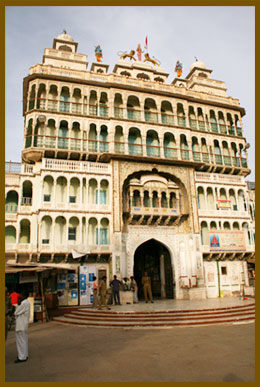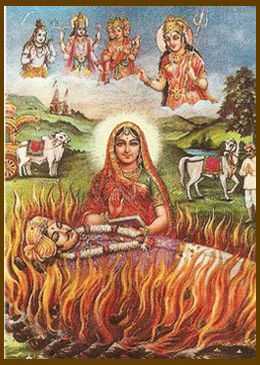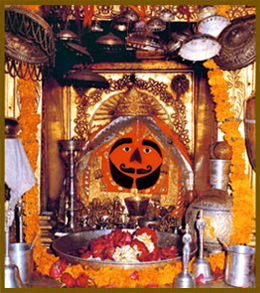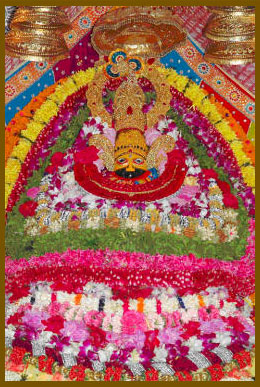Rani Sati Temple Jhunjhunu Rani Sati mandir is one of the most famous temples in Rajasthan. It is situated in Jhunjhunu town. It has a history of more than 400 years and is a testimony to feminine bravery and spirit which certainly captures the attention of all tourists. This temple is also famous for its magnanimous and rare paintings. It is also one of the oldest existing Indian pilgrimages. A special Pujanutsav is held on the occasion of Bhado Amavasya (no moon day). This day the temple is crowded with devotees in huge number. People from all over the country visit this place to offer their puja to Goddess Sati Devi. The most remarkable feature of this famous temple is that it does not hold any painting or statue of either female or male gods. Instead a trident depicting power and force is worshipped religiously by the followers. However one can surely find a beautiful portrait of Rani Sati in the pradhan mand. The temple consists of colorful wall paintings and is structured with white marbles. History of Rani Sati Temple It is the firm belief of Marwaris from Rajasthan that Rani Sati is an avatar of Maa Durga. The Marwari society of Rajasthan as well as from all other part of the country worship Rani Sati dadi daily in their houses. The history of Rani Sati starts from the time of Mahabharata. It is believed that Rani Sati was Utera, wife of Abhimanyu (son of Arjun). When Abhimanyu was killed in the battlefield, Utera decided to be Sati along with Abhimanyu’s funeral. However amidst all this Lord Krishna came to her rescue and pursued her against her decision. He also granted her wish of being married to Abhimanyu and her desire to be sati in her next life. As granted by Lord Krishna, in her next life she was born as the daughter of Gursamal in the village of Thukaye in Rajasthan. She was named – Narayani. Abhimanyu took birth in Hissar as son of Jaliram and named – Thandhan. Thandan and Narayani got married and were leading a peaceful life. He was in possession of a beautiful horse which was being eyed by the son of king of Hissar from quite some time. Thandan refused to hand over his precious horse to the king’s son. The king’s son then decides to forcefully acquire the horse and thus challenges Thandan for a combat. However Thandan fights the battle bravely and kills the King’s son instead. The enraged king thus kills Thandan in front of Narayani in the battle. Narayani symbolic to female bravery and power fights with the king and kills him. She then commanded Ranaji (the caretaker of the horse) to make immediate arrangements for her to be set a blazed along with her husband’s cremation. |
|
|||||||||
Salasar Balaji Salasar houses the famous Balaji Temple which attracts a large number of devotees from all over India. Shri Hanumanji, the famous Hindu deity of vigour and loyality, having been pleased by the devotion and worship of Shri Mohan Das Mahraj, appeared in the form of a statue on Saturday, Shrawan Sukla Navami, V.S. 1811 at Asota village. The statue was brought to Salasar where the temple was built. Later, the devotees added more buildings to the main temple. Two large fairs are held on Chaitra(April) and Ashwin purnimas(October) every year. Lacs of devotees from all over the country and abroad come and offer their wish before the great Hanumanji in the temple and have 'Darshan' of Shri Balaji throughout the year.Salasar is situated Sujangarh in Churu District. |
|
|||||||||
Khatu Shyamji Khatu Shyamji Temple is an important pilgrimage site in Rajasthan. However it is more popular for the annual fair that takes in the month of either February or March. The shrine is located at a distance of 48 kilometers from district of Sikar. From Jaipur this site is easily accessible. The mela or fair takes place on the occasion of Phalgun Sudi Dashmi and lasts till Dwadashi. It lasts for three days and a large number of devotees flock the fair. As is the case with Indian ceremonies this ceremony too is related to legends. It is said that when the battle of Kurukshetra (Mahabharata) was about to commence the grandson of Bhima (one of the Pandava)and son of Ghatotkacha , Barbarik expressed his desire to participate in the battle. Lord Krishna realized that if he took part in the battle the Kauravas would easily win because of his valor and justice will remain undelivered. So Krishna appeared in the disguise of a Brahmin and asked for Barbarik`s (Bhima`s grandson) head. Without any qualms he complied. Krishna was greatly moved by this sacrifice. In return of this sacrifice he was blessed with 2 boons by the lord. He was able to witness the battle of Kurukshetra from a hilltop. He was also to be worshipped as Shyam. The name Shyam belongs to Lord Krishna himself. It was the result of the boon that even today people worship Khatu Shyamji in memory of Barbarik.
Surjal Mata as Kuldevi This Mandir is Situted at Sudrasan near Badi Beri and Dhankholi. This Mata is considered as a Kuldevi of More Khandan |
|
More Family Contacts :  View & Download
View & Download




.jpg)